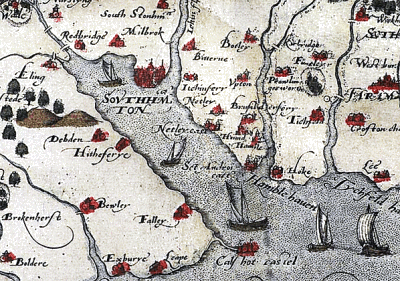The Pier Heritage
The Hythe Ferry (‘Hitheferye’) first appears on maps dated 1575. The first mention of a proposed pier is in an 1844 Act of Parliament but it’s not completed until January 1st 1881. The historic electric trains arrive in 1922 and have continued to operate ever since. That’s almost 450 years as a landing stage between Southampton and the New Forest.

After almost a decade of debate, false starts and hard work, the new Hythe Pier was officially opened on New Year’s Day, Saturday January 1, 1881.

Prior to this ferry passengers had to board the ferry boats at various points on an old Hard, a sort of stone pier dating from 1845 to the north of the present pier. Subject to the state of the tide and prevailing weather conditions passengers rather ran the gauntlet of getting their feet wet at the very least if the boat couldn’t get close enough. The old Hard was proving inadequate for the growing traffic so in November 1870 plans were lodged for a 2000 feet long pier, a much sought after dry landing for the Hythe Ferry.
The first plans were for a
very elaborate structure with a “steam bridge” landing pontoon at the
seaward end. This elaborate structure was also expensive, its undoing,
the reason it never came to be. Further plans for a much simpler
structure were put forward in early 1875 but once again the project fell
through. Another attempt was made in November 1877, third time lucky.
Excitement was high in the
local community but a lot of hard work still had to done to raise the
necessary capital. By July 1879 the required funds were in place and a
contractor had been employed to build the Pier. The iron work arrived in
October 1879 and work commenced. The last of the piles was driven on
June 29, 1880 when “flags were displayed in celebration of this
accomplishment”. Work continued throughout the rest of the year with the
completed structure receiving Board of Trade approval and accordingly
authority to operate in December 1880.
At 1 O’clock, accompanied
by his entourage, the Mayor of Southampton departed the Royal Pier in
Southampton by steam launch bound for the new Hythe Pier to perform the
official opening. The party was met at the pierhead by Mr E.A. Drummond,
the Chairman of the company that owned and had had the Pier built and
his Co-Directors.
In his speech the Mayor expressed his delight for the success of the
project and hoped that it would draw Hythe and Southampton closed
together. He concluded by declaring the Pier open and wishing all
present a happy and prosperous new year to a warm round of applause.
In reply, Mr Drummond thanked the Mayor for his wishes and his services. Three cheers were then shouted for the Mayor, the company’s directors and the Queen before the two official parties retired to the Drummond Arms for lunch.
Hampshire AdvertiserThe contract for the work was let to Messrs Bergheim and Company of London (the same contractors who built the Bournemouth Pier), upon plans designed by Mr. James Wright, C. E., of 10 Cornwell, London. The tender was £7,700, and it is believed that the cost will scarcely exceed that amount.
Saturday 5th January 1881
The pier is composed of a pair of longitudinal wrought iron open girders, resting upon groups of cast-iron screw piles, 40 feet apart, and well tied by diagonal and other braces, the girders themselves being held together with cross girders of nearly equal strength. The deck is formed of best pine joists, having the planks forming the floor, running in the direction of its length. The structure is singularly light, but possessing strength and rigidity far beyond any strains ever likely to be applied to it. The total length of the pier is a little over 2100 feet, terminating in a spacious pier-head. The width of the pier proper is 16ft, the total surface being nearly 36.000 square feet.
There are seven strong and very commodious landing stages, contiguous to the pier at different points along its length, so that everywhere passengers can land at all times of the tide. The stage at the pier head has at the lowest state of the tide a depth of 11ft. 6in. of water. Very neat wooden houses are erected at different points along the pier as shelter for those using it, and an elegant, commodious structure will shortly be erected upon the pier-head, embracing restaurant, waiting, music, and other rooms, for the use of the numerous visitors whom the beautiful promenade, the magnificent sea views, and charming scenery of the neighbourhood will attract.
At the shore end it is proposed to retain about 400 feet of the existing hard, which will be raised above the sea level and converted into a quay for the landing of cattle and heavy merchandise.
